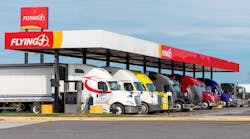Distillates—both diesel, trucking’s main fuel, and consumer gasoline—continued their slide nationwide on July 11, as the nationwide averages for diesel shed 10.7 cents to $5.568 per gallon and gas dropped 12.5 cents to $4.646, according to data from the U.S. Energy Information Administration (EIA).
The downward trend for diesel continued for a third week, as the U.S. average has shed 24.2 cents in that time. However, trucking’s main fuel still sits at record highs and $2.23 per gallon more than a year ago, which is causing widespread problems in the trucking industry to the tune of record fleet failures—as measured in “revocations” of operating authority for the month of June by the Federal Motor Carrier Safety Administration.
See also: Diesel drops after another record high
Motor club AAA also is measuring a decline in distillate prices. AAA’s national average for diesel of $5.642 also is down about a dime from a week ago and more than 12 cents from a month ago. AAA’s measure of gasoline is down almost 13 cents from a week ago and 32.6 cents from last month.
Regionally, according to EIA, diesel dropped the most for the week of July 11 on the East Coast and the Gulf Coast. In both regions, trucking’s main fuel was down 11.3 cents. It was down the most in the subregions of the Lower Atlantic, by 11.8 cents over last week, and California, where diesel dropped 11.4 cents. California and the West Coast, where trucking's main fuel is $6.863 per gallon, still have by far the most expensive diesel in the nation. The region with the smallest decline the week of July 11 was the Rocky Mountains, where diesel was down just 5.8 cents.
Cost of crude oil ticking down
Whereas record increases in both distillates were attributed to a kitchen sink of factors—inflation, oil prices, demand, lower inventories, reduced refining capacity, and the Russian invasion of Ukraine among them—a recent drop in crude prices and fears of a recession are being credited for the easing of diesel and gasoline prices the last month.
See also: With California law, trucking operations face uncertainty
Meanwhile, one analyst claims a global recession could demolish higher prices for oil and bring distillate prices that have soared to records since at least early March (though they started their ascent last year) crashing back to Earth. This analyst envisions $65-a-barrel prices for crude.
The price of oil, though, isn't nearly there yet. But there are positive indicators. Crude inventories are up 8.2 million barrels, according to FleetOwner’s sister publication, Oil & Gas Journal, excluding the Strategic Petroleum Reserve. The Biden administration has tapped the SPR at record amounts in recent months to try and bring high fuel prices down. President Biden said on July 8 that falling fuel prices are proof that his program to bring them down ‘is working.’






